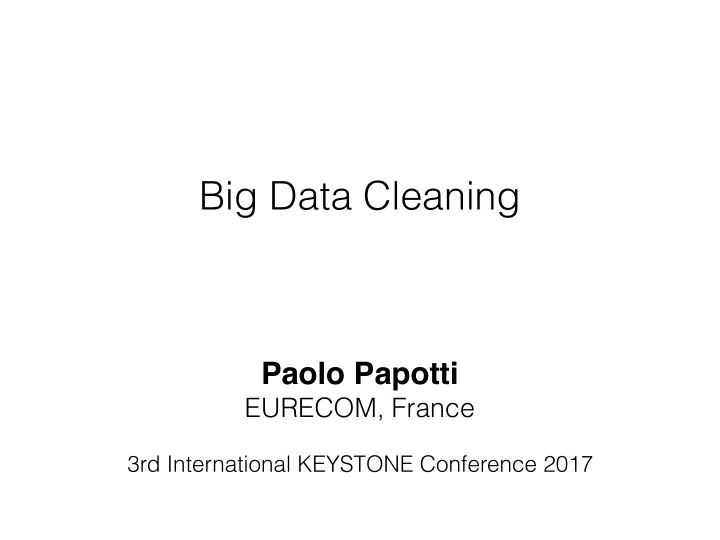

Big Data Cleaning Paolo Papotti EURECOM, France 3rd International KEYSTONE Conference 2017
2
up to 26% errors [Abedjan et al, 2015] 3
5% measurement errors 7% duplicate devices sensors with up to 30% errors 4
Is quality of data important? • Many decisions are taken after manually scrutinizing the data – Military attack • But more and more are taken by algorithms – Stocks trading – Credit report/Risk assessment – Self driving cars 5
But it is expensive! 6
Data quality facts “ engineers dedicated to data integration and cleaning” [CIO] “ 50 people curating products’ data” [Chief scientist] “Typical duration of an integration project is in terms of years ” [Former Chief Scientist] 7
[https://cloud.google.com/dataprep] 8
[https://cloud.google.com/dataprep] 8
Source 1 ! Target ! Source 2 ! Source 3 ! 9
Target ! Source 1 ! BEGIN TRANSACTION; SET CONSTRAINTS ALL DEFERRED;delete from target.PersonSet;delete from target.CarSet;delete from target.MakeSet;delete from target.CitySet; ------------------------------ TGDS ----------------------------------- create table work.TARGET_VALUES_TGD_v8_v3 AS select distinct null as v3id, rel_v8.cityName as v3name, rel_v8.region as v3region from source.CityRegionSet AS rel_v8; create table work.TARGET_VALUES_TGD_v5_v0v1 AS select distinct null as v0id, rel_v5.personName as v0name, null as v0age, 'SK{T='||'[0.0:'||rel_v5.personName||']'||'-'||'[1.1:'||rel_v5.carModel||']'||'J='||'['||'[0.0:'||rel_v5.personName||']'||'.0.2'||'-'||'[1.1:'||rel_v5.carModel||']'||'.1.3'||'V='||'['||'0.2'||'-'||'1.3'||'}' as v0carId, null as v0cityId, 'SK{T='||'[0.0:'||rel_v5.personName||']'||'-'||'[1.1:'||rel_v5.carModel||']'||'J='||'['||'[0.0:'||rel_v5.personName||']'||'.0.2'||'-'||'[1.1:'||rel_v5.carModel||']'||'.1.3'||'V='||'['||'0.2'||'-'||'1.3'||'}' as v1id, rel_v5.carModel as v1model, null as v1plate, null as v1makeId from source.PersonCarSet2 AS rel_v5; Source 2 ! create table work.TARGET_VALUES_TGD_v6_v0v3 AS select distinct null as v0id, rel_v6.personName as v0name, null as v0age, null as v0carId, 'SK{T='||'[0.0:'||rel_v6.personName||']'||'-'||'[2.4:'||rel_v6.cityName||']'||'J='||'['||'[0.0:'||rel_v6.personName||']'||'.0.5'||'-'||'[2.4:'||rel_v6.cityName||']'||'.2.6'||'V='||'['||'0.5'||'-'||'2.6'||'}' as v0cityId, 'SK{T='||'[0.0:'||rel_v6.personName||']'||'-'||'[2.4:'||rel_v6.cityName||']'||'J='||'['||'[0.0:'||rel_v6.personName||']'||'.0.5'||'-'||'[2.4:'||rel_v6.cityName||']'||'.2.6'||'V='||'['||'0.5'||'-'||'2.6'||'}' as v3id, rel_v6.cityName as v3name, null as v3region from source.PersonCitySet AS rel_v6; create table work.TARGET_VALUES_TGD_v7_v1v2 AS select distinct null as v1id, rel_v7.carModel as v1model, null as v1plate, 'SK{T='||'[1.1:'||rel_v7.carModel||']'||'-'||'[3.7:'||rel_v7.makeName||']'||'J='||'['||'[1.1:'||rel_v7.carModel||']'||'.1.8'||'-'||'[3.7:'||rel_v7.makeName||']'||'.3.9'||'V='||'['||'1.8'||'-'||'3.9'||'}' as v1makeId, 'SK{T='||'[1.1:'||rel_v7.carModel||']'||'-'||'[3.7:'||rel_v7.makeName||']'||'J='||'['||'[1.1:'||rel_v7.carModel||']'||'.1.8'||'-'||'[3.7:'||rel_v7.makeName||']'||'.3.9'||'V='||'['||'1.8'||'-'||'3.9'||'}' as v2id, rel_v7.makeName as v2name from source.CarMakeSet AS rel_v7; Source 3 ! create table work.TARGET_VALUES_TGD_v4_v0v1 AS select distinct null as v0id, rel_v4.personName as v0name, rel_v4.age as v0age, 'SK{T='||'[0.0:'||rel_v4.personName||'-'||'0.10:'||rel_v4.age||']'||'-'||'[1.11:'||rel_v4.carPlate||']'||'J='||'['||'[0.0:'||rel_v4.personName||'-'||'0.10:'||rel_v4.age||']'||'.0.2'||'-'||'[1.11:'|| rel_v4.carPlate||']'||'.1.3'||'V='||'['||'0.2'||'-'||'1.3'||'}' as v0carId, null as v0cityId, 'SK{T='||'[0.0:'||rel_v4.personName||'-'||'0.10:'||rel_v4.age||']'||'-'||'[1.11:'||rel_v4.carPlate||']'||'J='||'['||'[0.0:'||rel_v4.personName||'-'||'0.10:'||rel_v4.age||']'||'.0.2'||'-'||'[1.11:'|| rel_v4.carPlate||']'||'.1.3'||'V='||'['||'0.2'||'-'||'1.3'||'}' as v1id, null as v1model, rel_v4.carPlate as v1plate, null as v1makeId from source.PersonCarSet1 AS rel_v4; ----------------------- RESULT OF EXCHANGE --------------------------- insert into target.PersonSet select cast(work.TARGET_VALUES_TGD_v4_v0v1.v0id as text) as v0id, cast(work.TARGET_VALUES_TGD_v4_v0v1.v0name as text) as v0name, cast(work.TARGET_VALUES_TGD_v4_v0v1.v0age as text) as v0age, cast(work.TARGET_VALUES_TGD_v4_v0v1.v0carId as text) as v0carId, cast(work.TARGET_VALUES_TGD_v4_v0v1.v0cityId as text) as v0cityId from work.TARGET_VALUES_TGD_v4_v0v1 UNION select cast(work.TARGET_VALUES_TGD_v6_v0v3.v0id as text) as v0id, cast(work.TARGET_VALUES_TGD_v6_v0v3.v0name as text) as v0name, cast(work.TARGET_VALUES_TGD_v6_v0v3.v0age as text) as v0age, cast(work.TARGET_VALUES_TGD_v6_v0v3.v0carId as text) as v0carId, cast(work.TARGET_VALUES_TGD_v6_v0v3.v0cityId as text) as v0cityId from work.TARGET_VALUES_TGD_v6_v0v3 UNION select cast(work.TARGET_VALUES_TGD_v5_v0v1.v0id as text) as v0id, cast(work.TARGET_VALUES_TGD_v5_v0v1.v0name as text) as v0name, cast(work.TARGET_VALUES_TGD_v5_v0v1.v0age as text) as v0age, cast(work.TARGET_VALUES_TGD_v5_v0v1.v0carId as text) as v0carId, cast(work.TARGET_VALUES_TGD_v5_v0v1.v0cityId as text) as v0cityId from work.TARGET_VALUES_TGD_v5_v0v1; insert into target.CarSet select cast(work.TARGET_VALUES_TGD_v4_v0v1.v1id as text) as v1id, cast(work.TARGET_VALUES_TGD_v4_v0v1.v1model as text) as v1model, cast(work.TARGET_VALUES_TGD_v4_v0v1.v1plate as text) as v1plate, cast(work.TARGET_VALUES_TGD_v4_v0v1.v1makeId as text) as v1makeId from work.TARGET_VALUES_TGD_v4_v0v1 UNION select cast(work.TARGET_VALUES_TGD_v7_v1v2.v1id as text) as v1id, cast(work.TARGET_VALUES_TGD_v7_v1v2.v1model as text) as v1model, cast(work.TARGET_VALUES_TGD_v7_v1v2.v1plate as text) as v1plate, cast(work.TARGET_VALUES_TGD_v7_v1v2.v1makeId as text) as v1makeId from work.TARGET_VALUES_TGD_v7_v1v2 UNION select cast(work.TARGET_VALUES_TGD_v5_v0v1.v1id as text) as v1id, cast(work.TARGET_VALUES_TGD_v5_v0v1.v1model as text) as v1model, cast(work.TARGET_VALUES_TGD_v5_v0v1.v1plate as text) as v1plate, cast(work.TARGET_VALUES_TGD_v5_v0v1.v1makeId as text) as v1makeId from work.TARGET_VALUES_TGD_v5_v0v1; insert into target.MakeSet select cast(work.TARGET_VALUES_TGD_v7_v1v2.v2id as text) as v2id, cast(work.TARGET_VALUES_TGD_v7_v1v2.v2name as text) as v2name from work.TARGET_VALUES_TGD_v7_v1v2; 10 insert into target.CitySet select cast(work.TARGET_VALUES_TGD_v6_v0v3.v3id as text) as v3id, cast(work.TARGET_VALUES_TGD_v6_v0v3.v3name as text) as v3name, cast(work.TARGET_VALUES_TGD_v6_v0v3.v3region as text) as v3region from work.TARGET_VALUES_TGD_v6_v0v3 UNION select cast(work.TARGET_VALUES_TGD_v8_v3.v3id as text) as v3id, cast(work.TARGET_VALUES_TGD_v8_v3.v3name as text) as v3name,
Declarative Approach 1. Formalization clear notion of desired solution 2. Scalable algorithms handle large datasets Data Clean Extract Map Preparation 11
Data Cleaning ID FN LN ROLE ZIP ST SAL 105 Anne Nash E 85281 NY 110 211 Mark White M 15544 NY 80 386 Mark Lee E 85281 AZ 75 215 Anna Smith Nash E 85283 Up to 25% of business , health , and scientific data is dirty: errors , missing values , duplicates [ https://www.gartner.com/doc/3169421/magic-quadrant-data-quality-tools ] 12
Data Cleaning ID FN LN ROLE ZIP ST SAL 105 Anne Nash E 85281 NY 110 211 Mark White M 15544 NY 80 386 Mark Lee E 85281 AZ 75 215 Anna Smith Nash E 85283 • One declarative approach based on rules • Functional Dependency: zip code identifies state • A repair is an updated, consistent instance 15
Data Cleaning • Computing an optimal repair is a NP problem ID FN LN ROLE ZIP ST SAL 105 Anne Nash E 85281 NY 110 AZ 211 Mark White M 15544 NY 80 386 Mark Lee E 85281 AZ 75 215 Anna Smith Nash E 85283 • One declarative approach based on rules • Functional Dependency: zip code identifies state • A repair is an updated, consistent instance • An optimal repair is minimal in terms of number of changes between the original dataset and the repair 17
Data Cleaning • Computing an optimal repair is a NP problem ID FN LN ROLE ZIP ST SAL 105 Anne Nash E 85281 NY 110 211 Mark White M 15544 NY 80 386 Mark Lee E 85281 AZ 75 215 Anna Smith Nash E 85283 • Multiple possible ways to repair a violation • Domino effect : new violations could be generated by resolving a violation [Xu et al, 2013a] • Approximate solution with heuristics 18
Rule Based Data Cleaning • Functional dependencies [Bohannon et al, 2005], Conditional Function Dependencies [Cong et al, 2007], Conditional Inclusion Dependencies [Bravo et al, 2007], Matching Dependencies [Bertossi et al, 2011], Editing Rules [Fan et al, 2010], Fixing Rules [Tang, 2014] • Each fragment covers a new aspect: axioms, complexity study, heuristic repair algorithm • Sequence of repair algorithms: poor repair - 0.3 F-measure over real data • Piecemeal approach misses evidence! 20
Recommend
More recommend